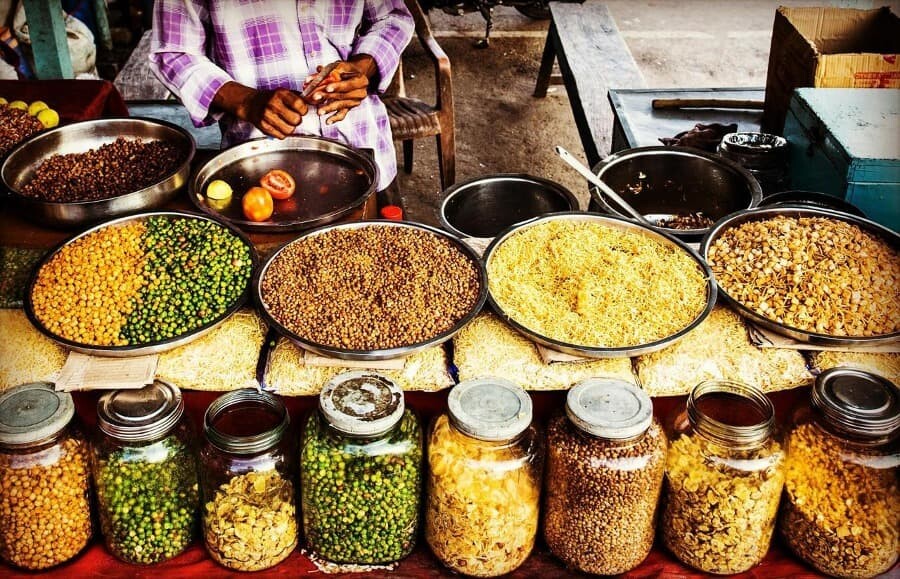As we always say, India is a wonderful country with infinite cultural richness, which is reflected in all aspects. The food we find there is a clear example. Its colors, spices, flavors, and cooking techniques leave no one indifferent who dares to try the most typical dishes.
Before naming some of the most typical dishes, let’s talk about the main characteristics. Spices play a crucial role in the cuisine.
The most common ones are:
- Turmeric: Gives a vibrant yellow color and has anti-inflammatory properties.
- Cumin: Used both in seeds and powder, it provides an earthy flavor.
- Coriander: Used fresh and in seeds or powder.
- Garam Masala: A spice mix that varies by region, but generally includes cinnamon, cloves, cardamom, and cumin.
Indian cuisine varies greatly among its different regions:
- North: Famous for its use of dairy products like yogurt and paneer. The dishes are usually richer and creamier.
- South: Known for its rice and coconut dishes, as well as spicy and tangy flavors.
- West: Includes dishes from Gujarat and Maharashtra, which are often sweeter and less spicy.
- East: Famous for its sweets and seafood, like those from West Bengal.
The diet in India can be vegetarian or non-vegetarian, with many people following a diet based on the religious teachings of Hinduism, Jainism, or Buddhism, which often promote vegetarianism.
Cooking techniques vary, including frying, grilling, steaming, and stewing. The use of the tandoor for roasting meats and breads like naan is also common.

MOST TYPICAL DISHES
CURRY
Curry is a dish characterized by its spice mix and intense flavor. Generally, an Indian curry can include a variety of ingredients such as:
- Meat: Chicken, lamb, fish, or seafood.
- Vegetables: Potatoes, spinach, eggplants, tomatoes, peas, cauliflower.
- Legumes: Lentils, chickpeas.
- Spices: Turmeric, cumin, coriander, cardamom, cinnamon, cloves, mustard, ginger, garlic, among others.
- Dairy: Yogurt, cream, or coconut milk.
- Rice or bread: Commonly served with basmati rice or breads like naan or roti.
There are many varieties of curry, such as masala curry, korma curry, vindaloo curry, and each region of India has its own variations and styles of preparation.
BIRYANI
Biryani is a popular and aromatic dish throughout South Asia, not only in India, and is made with mixed rice, spices, and generally meat (chicken, beef, goat, pork, lamb, shrimp, or fish). Sometimes it’s made with eggs or vegetables. It originated among the Muslims of the Indian subcontinent and is a staple in the cuisines of India, Pakistan, Bangladesh, Afghanistan, and Persia.
The key components of biryani typically include:
- Basmati Rice: A long-grain rice known for its fragrance.
- Meat or vegetables: Commonly marinated in yogurt and spices.
- Spices: A mix often including saffron, cardamom, cloves, bay leaves, cinnamon, nutmeg, and cumin.
- Herbs: Such as mint and coriander.
- Onions, garlic, and ginger: Usually fried to form a base.
- Yogurt: Used to tenderize the meat and add flavor.
The dish is typically cooked by layering marinated meat or vegetables.

SAMOSAS
Samosas are a popular snack known for their delicious flavor and crispy texture. They are triangles of stuffed dough, usually fried, though they can also be baked.
The samosa dough is made with flour, oil, and water, kneaded until firm. The filling can vary, but the most common ingredients include seasoned cooked potatoes, peas, and spices like cumin, coriander, ginger, garam masala, turmeric, and chilies. Sometimes ground lamb or chicken, lentils, or nuts are included.
To prepare them, the dough is divided into small portions, rolled out, and cut into semicircles. The filling is placed in the center of the dough, folded into a triangle, and sealed at the edges. They are fried in hot oil until golden and crispy, though they can also be baked for a healthier version.
Samosas are usually served with tamarind, mint, or coriander chutney and are a popular snack at parties, celebrations, and as street food.
NAAN
Naan is a type of flatbread known for its soft and fluffy texture and slightly smoky flavor when cooked in a tandoor, a clay oven.
The basic ingredients are: wheat flour, yeast or baking powder, yogurt, water, oil or clarified butter, salt, and sometimes sugar.
The ingredients are mixed and kneaded into a smooth, elastic dough. It is left to rest and ferment for a few hours to rise. The dough is divided into portions, rolled out into discs or oval shapes.
Traditionally, naan is cooked in a tandoor, where it sticks to the hot walls of the oven and cooks quickly. It can also be cooked on a griddle or grill at home.
There are variations like garlic naan, cheese naan, peshawari naan stuffed with nuts and raisins, or butter naan with butter.
It is traditionally served hot, often accompanying main dishes like curry, kebabs, or dhal (lentils).
DAL
Dal (also spelled dhal, daal, or dahl) is a legume-based dish, especially lentils, split peas, or beans.
It consists of:
- Legumes: Lentils (red, green, yellow, black), split peas, mung beans, among others.
- Spices: Cumin, turmeric, coriander, garam masala, mustard seeds, ginger, garlic, chilies.
- Optional vegetables: Tomatoes, onions, spinach.
- Liquid: Water or broth to cook the legumes.
- Oil or ghee: To cook the spices and add flavor.
The legumes are washed and cooked in water or broth until tender. The spices are fried in oil or ghee to release their flavors, often along with garlic, ginger, and onion. The spice mixture (tadka) is added to the cooked legumes and cooked together to combine the flavors. More water or broth can be added to achieve the desired consistency, whether thicker or more liquid.
There are variations like Tarka dal, Masoor Dal, Chana Dal, or Dal Makhani.
Dal is commonly served with rice (dal chawal) or flatbreads like naan or chapati. It is a basic accompaniment to many dishes and can vary from a light soup to a thick stew. It is an important source of plant-based protein in the vegetarian diet and is valued for its comforting and nutritious flavor.
MASALA DOSA
Masala dosa is a traditional dish from the south, known for its crispy rice and lentil crepe filled with a savory and spiced potato puree. It is a favorite for breakfast, although it is also consumed at other meals.
The ingredients are: rice, lentils (urad dal), and sometimes fenugreek.
The rice and lentils are soaked separately for several hours. Then they are ground into a fine paste. The batter is left to ferment overnight, giving it a slightly sour taste and airy texture.
It is filled with potatoes, onions, green chilies, ginger, mustard seeds, turmeric, curry leaves, coriander.
Masala dosa is traditionally served with various accompaniments, such as:
- Sambar: A lentil stew with vegetables and tamarind.
- Chutneys: Coconut, tomato, mint, or coriander.
- Tomato or onion chutney: To add extra flavor.
Masala dosa is appreciated for its combination of textures, with the crispy dosa and the soft, spiced filling, and it is a perfect showcase of the rich and varied cuisine of South India.
There are other typical dishes you cannot miss if you visit India, such as paneer, tandoori chicken, and many sweets.
This exotic country has a variety of things to offer you, so if you choose it for your volunteer experience, it will not leave you indifferent.




